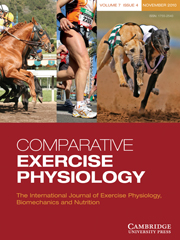Article contents
Effect of feed at different times prior to exercise and chelated chromium supplementation on the athletic performance of Mangalarga Marchador mares
Published online by Cambridge University Press: 14 March 2011
Abstract
Nutritional management studies to improve the performance of Mangalarga Marchador (MM) horses during the marcha test are limited. This study was designed to test the hypothesis that chelated trivalent chromium (CR) feed supplementation may reduce the suitability of the length of the interval between concentrate feeding and the marcha test among MM horses. A total of 12 healthy mares (4.25 ± 0.62 years) were randomly assigned to one of six dietary treatments (0 or 10 mg Cr by concentrate, fed 0.5, 2 or 4 h before exercise), according to a completely randomized design, with a split-plot arrangement. The diet was Cynodon pasture and concentrate (50:50 ratio). The first 29 days of the trial were for diet, Cr and exercise adaptation; during the next 15 days, horses were submitted to three 50-min field marcha tests, once a week. Heart rate (HR) was measured before, during and until 25 min after the exercise. Respiratory rate and rectal temperature were measured; blood samples were collected before, at the end and 25 min after the test. There was no effect of Cr by concentrate feeding strategy on any physiological variables (P>0.05). Supplementation of Cr increased glycaemia before and soon after the second marcha test (P < 0.01). In addition, Cr reduced HR during the second marcha test and decreased the time to first post-exercise HR recovery (P < 0.05). Insulinaemia was greater when the concentrate was provided 2 h prior to the test (P < 0.05). Concentrate provided 0.5 and 2 h before the test reduced plasma triacylglycerol in the first and second tests, respectively. The interval between concentrate feeding and marcha tests should not be decreased in horses supplemented with Cr. Horses should be fed more than 2 h before that test. Cr supplementation during training may improve the cardiac performance of MM mares during the marcha test.
Information
- Type
- Research Paper
- Information
- Copyright
- Copyright © Cambridge University Press 2011
References
- 4
- Cited by

